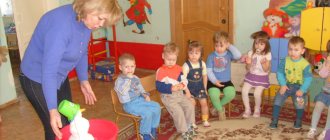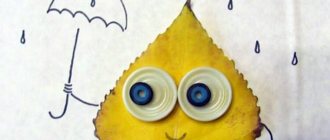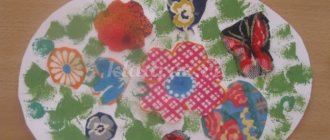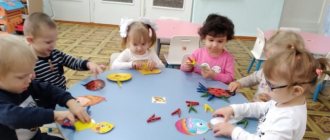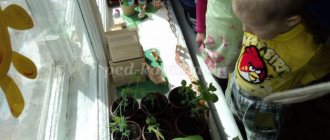Methods of teaching applications in the second junior group of kindergarten.
Visual activities in kindergarten
APPLICATION
2nd junior group
Application
Application
(from Latin appllcatio -
apply, apply
) - one of the types of applied art used for the artistic design of various objects (clothing, furniture, dishes, etc.) by attaching cut out decorative or thematic shapes to the main background. The originality of the applique lies both in the nature of the image and in the technique of its execution. The image in the appliqué is highly conventional compared to other types of planar images - drawing, painting. The applique is characterized by a more general form, almost without details. Most often, a local color is used, without shades, and one color is sharply different from another. The appliqué process involves two steps: cutting out individual shapes and attaching them to the background. As a means of decoration, appliqué creates a unique decorative effect. Sometimes cut-out shapes are used to decorate a room (for example, paper napkins and lace for decorating shelves, various multi-colored shapes for gluing onto glass windows as a festive decoration). Applique cut-outs from fabric, fur and leather are used to decorate clothes and make panels. Sometimes the cut out parts are not completely attached to the background, and the applique turns out to be partially voluminous. For example, the petals of a flower are attached only at the middle, and its ends lag behind the background. This gives greater expressiveness to the image. The simplicity and ease of execution of the applique make it accessible to children's creativity. Children can either use ready-made forms, painted in certain colors, or create compositions by cutting out elements of patterns, plot images, etc. Thus, applique classes contribute, on the one hand, to the formation of fine arts and skills, on the other hand, to the development of creative children's abilities.
Types of applications in kindergarten
Preschoolers master all the processes of making appliqué—cutting and gluing shapes. Preparatory exercises for mastering this type of activity are games with mosaics, with the help of which children, laying out ready-made geometric shapes, become familiar with their features, color, arrangement methods, and principles of creating a pattern. Cutting without gluing helps master the applique process (children cut paper, making tickets, flags, etc. for the game, learn to use scissors). In kindergarten, they use such types of appliqué work as gluing ready-made forms (decorative - from geometric and plant forms and object - from individual parts or silhouettes) and cutting and gluing forms (individual objects, plot, decorative). Preschoolers can cut out shapes in sections or as a silhouette. Composing an object from separate parts is easier for them, like any constructive image in drawing or modeling. Silhouette cutting is more difficult for children, since they always need to compare the general contours of the object with the proportions of its individual parts. Therefore, cutting out complex shapes is included in the program only in the preparatory group. The application contains great opportunities for the development of imagination, imagination, and creative abilities of children. Thus, the pattern can be made up of both ready-made geometric and plant shapes cut out by the children themselves. The use of ready-made forms in decorative works allows preschoolers to focus all their attention on the rhythmic alternation of elements in a pattern and the selection of beautiful color combinations. Children use the skills acquired in appliqué classes in other activities, mainly in design, making shadow theater, light decorations, and Christmas tree decorations.
Equipment
and materials for performing applique
For appliqué work, white and colored paper of various grades are used. For the background, take thicker paper - white from sketchbooks, colored table paper, thin cardboard. The forms to be glued are cut out of thin paper, preferably glossy. It comes in bright colors and is pleasant to the touch, which is especially important for working with young children. Older preschoolers also use matte colored paper of various colors and shades. If the desired shades of color are not available, the paper can be dyed. It is better to do this work not with the whole group, but with several children outside of class. Forms must be carefully prepared for classes. Geometric shapes must exactly match each other in size, which makes it possible to create a single pattern from them (for example, the side of a triangle should be equal to the side of a square or rhombus, etc.). To paste objects in the younger group, you need to prepare silhouette images or parts of the object. For classes in the middle and sometimes in the senior group, paper is cut in advance into pieces of a certain size in accordance with the task. For example, for gluing a house, they give a ready-made piece of paper representing the walls; Children cut out a roof from a strip of a different color, etc. This blank will help children maintain its shape and correctly convey the size and proportions of the parts of the house. For older preschoolers, forms of various colors and shades are used, since in these groups mainly decorative gluing is carried out from geometric shapes according to the children's plans, and they need to be provided with a wide choice of material. The use of shapes of different colors contributes to the manifestation of independence and creativity in work. Children can, if the task allows, choose the color of their choice. Particularly important is the selection of a variety of colored forms and paper in classes, the purpose of which is to independently compose beautiful color combinations. When cutting out objects, it is advisable to prepare a set of the necessary paper for each child in advance. For children in the preparatory group, all the material can be in one place. In all cases, both when gluing finished forms and when cutting, you should have more material than is necessary to complete the task. The glue is prepared from potato starch, since after it dries, no traces remain on the paper, which is very important for maintaining a neat appearance of the work. Children are given glue brushes; in older groups, hair brushes are sometimes used to apply small parts. Scissors should be small in size, with rounded ends and freely moving arms so that they can easily be moved by the child's fingers. The correctness of the created form will depend on this. Trays and flat boxes for ready-made forms, paper, scraps are placed in such quantities that it is convenient for children to use them. Each child is given an oilcloth for applying glue to the molds, a cloth and a brush stand. Such extensive equipment must be arranged so that tables are not cluttered during work. At the beginning of the lesson, only the material that will be needed at the beginning is displayed; then, as needed, new accessories are added and unnecessary ones are removed. The furnishings on the tables should remain neat and aesthetically pleasing until the end of the lesson. Thus, the application process requires a fairly large amount of materials and tools, which must be prepared in advance.
Tasks
and program material for appliqué
Learning appliqué involves familiarizing yourself with the material, acquiring the ability to cut out various shapes, arrange them on a sheet of paper in a certain order and paste them in accordance with the image and plot. The main tasks of learning applique are the following: - distinguish geometric shapes, know their names (circle, square, oval, rectangle, triangle, rhombus); -introduce primary, complementary colors and their shades, mastering the ability to create harmonious combinations; -know the sizes and quantities: large, small forms; one form is larger (smaller) than another, one, several, many forms; -develop compositional skills: rhythmically arrange identical forms in a row or alternate two or more forms; build an image depending on the shape of the sheet - on a strip, square, rectangle, circle; - create an image of an object from separate parts; -arrange objects in a plot applique. Mastering basic cutting techniques: a) cutting paper straight, along folds and by eye; b) cutting out rounded shapes by rounding corners, symmetrical shapes from paper folded in half, several times, like an accordion; c) cutting out asymmetrical shapes - silhouette and from separate parts; d) cutting along the contour; e) creating a shape by tearing off pieces of paper. Mastering basic gluing techniques (using a brush, glue, rag; the ability to sequentially glue forms). Let's consider the content of program material for different age groups. Appliqué classes begin with the second junior group ;
in the first junior group, children prepare for these activities by playing games with colored mosaics; at their own request or as shown by the teacher, they lay out the shapes in a row, alternating by color, making simple objects from them - a house, a flower, etc. In the fourth year of life, the child is able to realize his simple idea in the image, can master some technical skills. In this regard, applique is a more difficult type of activity in terms of technique than drawing or modeling, since the methods of its implementation are more complex and the result obtained is more conditional. The objectives of teaching applique in this age group are the following: familiarization with the geometric shapes that are part of many objects - a circle, a square, a triangle; knowledge of colors - red, yellow, blue, green, white, black; knowledge of the concepts of “quantity” (one, two, three, many), “size” (large, small, more, less); development of compositional skills in arranging shapes in a pattern (in a row, along the edge, in the corners) and parts of objects; mastering the skill of gluing forms. The development of motor functions of the hand in children of the fourth year of life is still imperfect, so they are not able to use scissors. True, a child can be taught this skill in a family setting. In this regard, the solution of the tasks set by the program takes place in classes with ready-made forms. Mastering the skill of making appliqué begins with gluing several shapes in one row on a strip of paper. Even this simple task requires knowledge of the features of the new pictorial form, its name and color, the ability to arrange the forms in a horizontal row, the skill of correctly applying glue and gluing the forms in the right place. So that the child can cope with this task, a circle shape is given for gluing, which is equally symmetrical along the entire contour, has no top and bottom and does not change depending on the location; to place the elements, they offer a narrow strip of paper, on which it is impossible to arrange the circles in any other way than in a row; all shapes have the same color. This makes completing the task easier: children must remember the name of the shape, its color and master the gluing technique. In the first lessons, sometimes the main difficulty for kids is the gluing process: they need to learn how to hold the brush correctly, pick up a little glue, carefully spread the form on the back side, using a special oilcloth, lay the forms in place with the smeared side, press them with a cloth, do not move them, put them down brush only on the stand. At first, the gluing technique completely absorbs the children's attention. Further complication of the program material occurs due to the introduction of circles of a different color and their arrangement in alternating colors. Then a new shape is introduced - a square. When making a composition of squares, you must ensure that they all fit exactly on one side. The composition of the appliques gradually becomes more complicated - children place and stick the shapes at the corners of the square and along the edge of the circle. These elements of the form are clearly highlighted by the form itself and are easily recognized by the child. Gluing in the center is still difficult for children in the younger group. Along with mastering the principles of the rhythmic arrangement of one or two elements, the program provides for gluing object images, first consisting of one, then of 2-3 parts (for example, a mushroom, a flag, a snowman, a house, etc.). The difficulty of these tasks is that the object and its parts must be located depending on its design: the stem of the mushroom goes down from the middle of the cap, the roof is located above the walls of the house, etc. However, kids will successfully cope with such work, since the subject tasks content is understandable to them. In addition, for the image they select objects with a symmetrical arrangement of parts, with shapes close to the geometric ones, which the children became acquainted with in the first lessons. I. L. Gusarova recommends starting appliqué work in the younger group by completing tasks that have a specific visual task - creating a familiar object. Interest in the topic will help the preschooler overcome both constructive and technical difficulties. A small child understands better the task of putting together an object from 2-3 parts than arranging geometric shapes according to the principle of alternation and symmetry in a pattern. In the first case, he himself will notice the mistakes made, since the logic of the content will be violated. The principle of alternating and repeating pattern elements will be mastered successfully when gluing flags or beads onto a drawn thread. Thus, for children of this age, each appliqué task, as well as drawing and sculpting, should be associated with a specific image. The teacher’s task is to select appropriate subject names for all decorative tasks of gluing geometric shapes - “decorate a handkerchief” (square ), “paint a plate” (circle), etc. The concept of the connection between the themes of children’s works and ideas about specific objects formed the basis of an appliqué album developed by E. E. Lootsar. All topics in it for the younger group are of a subject nature. So, the circles are glued not to a strip, but to a pre-prepared cup or saucer shape. The squares represent windows pasted onto the silhouette of the house, etc.
Methods
of teaching appliqué
in the 2nd
junior group of kindergarten
Teaching appliqué, like teaching other types of visual activities, is based on the development of children’s perceptions . Enriching their ideas about shapes, sizes, colors, and various relationships of objects in the world around them will help the work of thought and imagination during classes. Let's consider the specific features of using different teaching methods in appliqué classes in different age groups of kindergarten. Second
junior group .
For young children, material for work and the organization of the learning process are of great importance. The material for making the appliqué can be so bright that it can often distract children’s attention from the teacher’s explanations. Therefore, in the younger group, especially at first, ready-made forms for sticking are distributed to each child in a special bag after explaining the task. Children in this group are not yet able to use common material, since they do not know how to distinguish the shapes and colors of elements for gluing. After the teacher’s explanation has been heard and the forms for sticking have been distributed, the children lay them out on a sheet of paper in accordance with the assignment. The teacher checks the correct arrangement of the elements. Therefore, in the first classes in the younger group, glue is placed on the tables only after the teacher has checked all the work, immediately before the gluing process. This will allow the teacher to monitor the correct construction of the image and help children master the gluing technique. In the future, all equipment, except for color forms, can be prepared in advance. As is known, in teaching a teacher must rely primarily on the direct perception of children. Examination of an object during appliqué classes will be used to revive preschoolers’ ideas about the features of the shape, color of an object, etc. Since the image in the applique is associated with a large generalization of forms, examination of nature should be accompanied by showing samples made by the teacher, especially in the first lessons. These generalized forms of an object and their similarity to geometric ones are difficult for children to identify when examining, since they are obscured by a number of details. In the sample this shape is clearly indicated and details may be omitted. While showing the sample to the younger group, the teacher clearly names the color of the form and, if necessary, traces it with his finger, emphasizing its features. Since in the younger group the main task of teaching is to familiarize children with various forms and techniques of gluing, a sample is most often shown for exact repetition. But preschoolers should also be taught to independently solve certain problems during repeated lessons. For example, after becoming familiar with the shape of a circle and the techniques for gluing it on a strip, you can offer to choose circles of any color for gluing beads. The teacher's demonstration of work techniques is necessary to develop the correct skills in children. Moreover, the demonstration of the most complex techniques is given until the teacher is convinced that the kids have mastered them and can independently apply them in their work. The teacher also shows the sequence of the application: what form he takes, how he places it on the paper, explains at what distance from it another form should be placed, etc. After laying out, he shows and explains the gluing process if the children have not yet mastered it . The teacher accompanies each action with an explanation. The demonstration is not carried out in cases where children understand the process of laying out and gluing. The teacher, using the example, explains the task and reminds some working techniques. For children who find it difficult to complete a task, he shows these techniques individually.
application curriculum for the first junior group
APPLICATION
Educational field "Artistic creativity"
We introduce children to the fine arts and develop children's artistic creativity
LITERATURE
- Lykova I.A. Visual activities in kindergarten: planning, lesson notes, methodological recommendations. Early age.- M.: “Karapuz”, 2010.-144p.
- Yanushko E.A. Application for young children (1-3 years old). Methodological manual for educators and parents.
- Malysheva A, N. Application: gifts, cards, souvenirs. - Yaroslavl: Development Academy LLC, 2011. - 128 pp., ill.
- Zaitsev V.B. Crafts from leaves. - M., 2011
- Productive activities with young children. Author: E.V. Polozova. Educational and methodological manual for educators and methodologists. - IP Lakotsenin S.S., Voronezh. - 2009.
- Zaitsev V.B. New Year's toys.
- Zaitsev V.B. Origami.
- Zaitsev V.B. Application.
September
Topic of classes
Goals and objectives
literature
1. “Shadow, shadow, shadow – these are the pictures we have!”
Introducing silhouette pictures as a type of image of objects. Learn to look at silhouette images, recognize and name them. Develop aesthetic perception. Foster independence, confidence, and activity.
No. 1, p. 23
2. “These are the leaves we have!” (teamwork)
Arouse interest in creating a collective panel of autumn leaves. Learn to lay out leaves on a blue background and glue them. Develop a sense of color and shape. Cultivate interest in bright, beautiful natural phenomena.
No. 1, p. 24
3. “Flowers” (from dry leaves)
Learn to position the blanks correctly when creating a flower; use glue correctly. Develop aesthetic taste. Cultivate an interest in working with natural materials.
No. 4, page 12
4. "Postcards"
Teach children to use blanks correctly and develop an interest in appliqué. Cultivate interest when working with glue, accuracy
No. 2, p. 4
5. “Vegetables and fruits for the winter”
Teach children to stick ready-made shapes and distinguish between red and green colors. Cultivate interest in doing work. Develop a sense of rhythm and eye.
No. 3, p. 4
October
Topic of classes
Goals and objectives
literature
1. "Caterpillar"
Learn to compose an image of an object from identical shapes (circles). Develop a sense of color and shape. Cultivate an interest in working with glue.
No. 3, p. 8
2. “The leaves are dancing”
Learn to lay out ready-made shapes of different colors and sizes and glue them. Continue familiarization with the gluing technique: learn to distinguish between the front and back sides of the paper, apply glue to the back, apply it to the background and apply it with a napkin.
No. 1, p. 30
3. “Polka Dot Dress”
Teach children how to use stickers correctly; generate interest in the application. Develop a sense of rhythm, color, shape. Cultivate accuracy when working with glue.
No. 2, p. 18
No. 3, p. 64
4. "Magic Bottle"
Introduce children to the properties of paper (sensory development). Learn to crumple paper and form it into lumps.
No. 2, p. 22
5. "Balloons"
Learn to correlate objects by color and shape, to distinguish a certain color from many others.
No. 3, p. 6
november
Topic of classes
Goals and objectives
literature
1. “Fluffy Cloud”
Involve children in co-creation with the teacher: tear the paper into pieces, crumple it into lumps and glue it to the silhouette of a large cloud. Introduce the elements of paper plastic. Arouse interest in teamwork.
No. 1, p. 35
2. “Box of Candy”
Teach children to stick candy blanks into a box using glue and a brush. Develop attention and accuracy.
No., page
3. “Beautiful bottle”
Learn how to glue blanks onto a three-dimensional object; generate interest in the application. Develop a sense of shape and color. Cultivate accuracy when working with glue.
No. 2, pp. 19-20
4. “Beads for Mommy”
Learn to alternate objects by size, size, and assign the names of blue and red colors. Develop an interest in working with glue. Cultivate accuracy and attention.
No. 3, p. 12
5. “Colorful pebbles”
Continue to introduce children to paper and its properties (sensory development). Learn to crumple paper, roll it into lumps, and glue them to cardboard. Create interest and a positive attitude towards the application.
No. 2, p. 23
December
Topic of classes
Goals and objectives
literature
1. "Snowflakes"
Teach children to apply glue to the entire surface of the snowflake, carefully sprinkle it with semolina. Develop the ability to draw straight lines with a brush. Cultivate an interest in working with available materials.
No., page
2. "Snowman"
Teach children to create the image of a snowman. Continue teaching the elements of paper plastic art. Vary the gluing technique: dip the crumpled lumps in glue and attach to the background, pressing firmly.
No. 3, p. 32
3. “Holiday Christmas tree”
Teach children to create an image of a Christmas tree based on an unfinished composition (the silhouette of a Christmas tree). Continue teaching the elements of paper plastic art. Learn to glue lumps chaotically - these are lights or in an orderly manner - these are beads. Foster independence and interest in work.
No. 1, page 45
No. 3, p. 14
No. 6, p. 6
4. “Decorate the scarf with a pattern”
Teach children to create an image of a scarf with a pattern of geometric shapes. Fix the names of colors and shapes (circle, square). Cultivate responsiveness in children. Accuracy.
No. 5, p. 65
5. “Multi-colored garland”
Learn to glue finished pieces together using glue. Develop a sense of color and shape. Foster a sense of empathy and mutual support.
No. 7, p. 6
January
Topic of classes
Goals and objectives
literature
1. “Giant Snowman”
Arouse interest in the image of a giant snowman in collaboration with the teacher and other children. Develop the ability to form white lumps of cotton wool, dip them in glue and apply them to the silhouette of a snowman within the drawn outline.
No. 1, page 47
2. “Let’s decorate the mittens”
Learn to make a pattern on the base, placing it in the middle and along the edge. Develop a sense of color and shape. Cultivate interest in the application.
No. 3, p. 54
3. Frame “Snowflakes”
Teach children to create a frame based on a sample together with the teacher. Arouse interest in working with glue and paper. Learn to correctly place the proposed pictures along the contour of the frame. Cultivate accuracy and cooperation in work.
No. 8, p. 12
4. “Rug for rabbits”
Learn to alternate geometric shapes (circle, triangle), placing them in the middle of the base. To consolidate knowledge of flowers, encourage them to name them.
No. 3, p. 10
No. 5, p. 74
5. “The bun rolled along the forest path”
Learn to create an expressive image of a Kolobok using the paper plastic technique: crumple a paper napkin into a ball and stick it on a path drawn with a felt-tip pen in the form of a curved line. Develop fine motor skills of the hands, consistency in the work of both hands.
No. 1, p. 50
February
Topic of classes
Goals and objectives
literature
1. "Patchwork Quilt"
Arouse interest in creating the image of a patchwork quilt from beautiful candy wrappers: glue the candy wrappers onto the base and create a collective composition from individual works. Bring to practical mastery of the concepts of “part” and “whole”.
No. 1, p. 56
2. "Hearts"
Learn to create beautiful compositions. Develop the ability to correctly position blanks based on a postcard. Cultivate neatness.
No., page
3. "Boat"
Learn to create an entire composition from individual blanks, and correctly position the blanks on cardboard. Cultivate accuracy when working with glue.
No. 3, page 24
4. "Cars"
Strengthen children's practical appliqué skills. Form spatial representations - learn to correctly place images on a base and glue them.
No. 2, p. 41
March
Topic of classes
Goals and objectives
literature
1. “Beads for my beloved mother!”
Teach children to create a composition from blanks and designs, alternating them by color and shape.
No. 3, p. 12
2. “Postcard for mom “MIMOSA””
Create a mimosa look using yellow napkins. Learn to create an expressive image of MIMOSA using the paper plastic technique: crumpling paper napkins and gluing them onto a base. Cultivate interest in the application.
No., page
3. “Willow Twig”
Continue to teach children to create an image of an object - a willow - by gluing white balls (cotton wool or polystyrene foam) onto a twig. Develop finger motor skills. Cultivate an interest in working with available materials.
No. 3, p. 106
4. “Elegant dress”
To teach children to convey the shape of a dress, highlighting the characteristic details of the silhouette, to develop the ability to select dress decoration elements that beautifully match each other in color and with the background of the colored base of the dress.
No. 3, p. 64
5. “Birdhouse”
Learn to place appliqué parts based on a sample, practice distinguishing and naming familiar geometric shapes. Cultivate a caring attitude towards birds.
No. 3, p. 20
April
Topic of classes
Goals and objectives
literature
1. "Flags"
Teach children to create a linear composition from flags alternating in color (or shape). Arouse interest in decorating flags with decorative elements. Develop a sense of color and shape.
No. 1, p. 74
2. "Rocket"
Learn to create an image of a rocket by gluing a blank. Develop spatial thinking, correct arrangement of parts on the sheet. Cultivate accuracy when working with glue.
No. 3, p.92
3. “Easter egg”
Arouse children's interest in working on creating the Easter composition, teach them to symmetrically distribute the blanks - decorations on the Easter egg.
No., page
4. “The sun will shine brightly”
Learn to create an image of the sun by gluing blanks, repeating the name of the color (yellow) and shape (circle), adding rays with pencils.
No., page
5. “Visiting the hedgehog” (collective work “basket for the hedgehog”)
Learn to create the image of a mushroom by gluing 2 blanks of different shapes. Foster respect for the environment and love for animals.
No., page
May
Topic of classes
Goals and objectives
literature
1. “Spring Flowers” (“Narcissus”)
Learn to create an image of a spring flower by arranging the composition correctly. Develop the ability to perform consistency in work. Cultivate love for the world around us.
No. 3, p. 103
2. “Colorful fireworks”
Arouse interest in creating fireworks in collaboration with the teacher. Create conditions for experimenting with different materials (cotton swabs, a piece of foam rubber, a brush).
No., page
3. “Fruit bowl”
Learn to compose a still life composition from 3-4 objects by gluing ready-made blanks. Repetition of shapes and colors. Cultivate accuracy when working with glue.
No. 3, p. 46
4. “Balloons, obedient to the breeze...”
Arouse interest in creating applicative pictures from 5-7 balloons of the same shape and size, but different in color. Learn to lay out ready-made forms at a certain distance from each other or with partial overlap, filling the entire space of the sheet. Develop a sense of form and rhythm.
No. 1, p. 80
Author: Kolesnichenko Oksana Anatolyevna.
